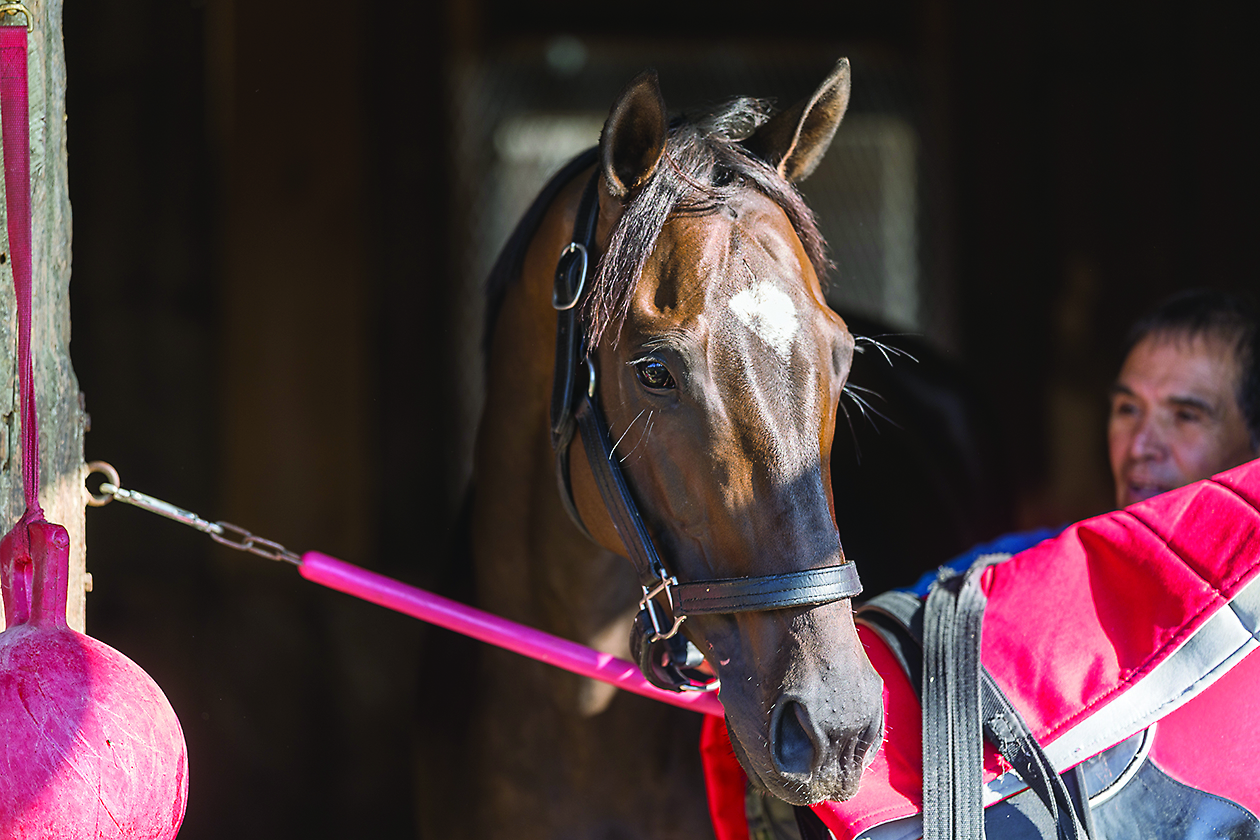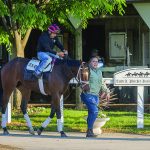When the voice on the other end of the phone belongs to Jerry D. Bailey and in answering a question about a horse he rode 36 years ago he mentions the horse in the same sentence as Cigar, it instantly becomes an E.F. Hutton moment.
When Jerry Bailey talks Cigar, people listen.
The inquiry concerned Fit To Fight, winner of the New York Handicap Triple Crown in 1984, the fourth and most likely last horse to accomplish that feat.
“Maybe one of my favorite horses, behind Cigar,” said Bailey, who piloted “the incomparable, invincible, unbeatable Cigar” (thank you, Tom Durkin) to 15 straight wins. “He (Fit To Fight) was an overachiever. He was not necessarily the most talented, but he made no mistakes and he made my job easy. He had ratable speed and he carried it well. He was like the little engine that could.”
There was a time that the Handicap Triple Crown – consisting of the Met Mile, Suburban and Brooklyn, dating back to the 1880s – was a big deal. Winning it went from an improbability to an impossibility when NYRA put both the Met Mile (Metropolitan Handicap) and Brooklyn on the Belmont Stakes undercard in 2014.
This year, the Brooklyn and Met Mile were scheduled to be run June 6. Then the coronavirus came; the Met Mile and Suburban will be run Saturday with the Brooklyn on hiatus for the spring-summer meeting.
When Fit To Fight swept the series – joining Whisk Broom II (1913), Tom Fool (1953) and Kelso (1961) – it was a significant achievement, not only for the horse but for Bailey’s Hall of Fame career, in which he won 5,893 races and seven Eclipse Awards.
“He was my first big horse,” Bailey said. “I had come to New York in 1982 and I was doing OK, but I hadn’t broken through yet. I was trying to get into Rokeby Stables and he got me in.”
Bailey won the Jerome with Fit To Fight, the first time he rode him, as a 3-year-old in 1982. He got a leg up on the son of Chieftain and the One Count mare Hasty Queen II 16 times, with nine wins, two seconds and two thirds. The horse lost six straight at one point in 1983, before winning two allowance races, finishing second in the Vosburgh and taking the Stuyvesant.
The Vosburgh loss came at the hooves of A Phenomenon, a defeat Fit To Fight would avenge in a thrilling edition of the Met Mile in 1984, the first leg of the Handicap Triple Crown. Fit To Fight drew the rail, which didn’t please trainer Mack Miller, but Bailey kept him in the clear and tracked A Phenomenon down the backstretch, with Dixieland Band in the fray until the stretch.
Fit To Fight and A Phenomenon hooked up for a knockdown, drag-out stretch battle, with Bailey edging Angel Cordero Jr. by a head.
“I knew Cordero was going to have something in reserve, so I wanted to make a little premature move,” Bailey said. “It was a dog fight from the middle of the stretch on.”
Bailey called the Met Mile triumph his “stepping off” point in New York, but he didn’t stick around to celebrate, as he was booked on a flight to St. Louis right after the race to meet Suzee Chulick’s parents for the first time and he wasn’t about to miss it.
“As much as I loved the horse, I loved her more,” said Bailey, who has been married to Suzee for 35 years. Good call.
Fit To Fight, whom Rokeby bought at the Fasig-Tipton Saratoga sale for $175,000 as a yearling, had a much easier time of it in the second two legs, winning the Suburban by 3 3/4 lengths July 4 and the Brooklyn in the slop by 12 1/2 lengths 17 days later. He was odds-on in both and was never threatened, despite carrying 129 pounds in the Brooklyn, 18 more than the runner-up, Vision.
“He gave you everything he had and then he gave you some more,” said Bailey, who was able to put his hands on a copy of the horse’s lifetime PPs almost instantly, something he said is only the case with a few horses he rode.
While sweeping the Handicap Triple Crown has proved to be extremely difficult, winning two of the three legs is no small feat, with seven horses on that list, including Grey Lag (1923, Met Mile-Suburban), Equipoise (1933, Met Mile-Suburban), Devil Diver (1944, Met Mile-Suburban), 1946 Triple Crown winner Assault (1947, Suburban-Brooklyn), Buckpasser (1967, Met Mile-Suburban) and Forego (1975, Brooklyn-Suburban and 1976, Met Mile-Brooklyn).
The most recent was In Excess, who captured the Met Mile and Suburban in 1991 and passed on the Brooklyn, which was run three weeks after the Breeders’ Cup, on Nov. 23.
In Excess, a son of Siberian Express bred in Ireland by Ahmed F. Foustok, raced in England as a 2-year-old and halfway through his 3-year-old campaign, until trainer Bruce L. Jackson bought him for Jack Munari and brought him to California. He finished second by a head in his U.S. debut in the 1990 Oceanside Stakes at Del Mar, with Gary Stevens up.
That was followed by a seventh in the Del Mar Derby, which Jackson called a “demolition derby” and “one of the wildest races I’ve ever seen.” The stewards disqualified Tight Spot for allegedly causing severe crowding 100 yards after the start – they clearly had left the stand before Bayern’s 2014 opening act in the Breeders’ Cup Classic – but the California Horse Racing Board reversed the decision 38 days later.
In Excess moved to the dirt and started his 4-year-old campaign with a win in the Grade 2 San Fernando, followed by a third in the Grade 1 Strub and fourth in the Grade 1 Santa Anita Handicap. Jackson had no intentions to ship him to the East Coast, but a temporary foot injury altered his plans and he sent him to Belmont for the Met Mile. With Stevens committed to other mounts at Hollywood Park that day, Patrick Valenzuela made the trip and guided In Excess to a 2-length win over Rubiano at 4-1 odds.
“I always thought he was going to be good on dirt,” said Jackson, retired and living in California. “He always worked sensationally on dirt.”
Stevens got back aboard for the July 4 Suburban, winning by a length as the even-money favorite. The Whitney was next, and while it looked easy, Stevens said the victory came with a large portion of angst.
“Bruce told me before the race that he had a foot issue a few days before the race,” Stevens said, which was caused by being spooked by the sound of something falling off a milk truck while he was on the wash rack.
“Bruce said, ‘you may think you’re sitting on much the best horse, but ride him like you’re not on the best horse,’ ” Stevens said. As it turns out, there was nothing to worry about as the horse was never challenged and won handily.
“He was a really special horse,” Stevens said, “one of the best I rode. He was a good-looking horse, very intelligent and he loved to train.”
Stevens learned that the hard way.
“The first time I worked him Bruce told me to go (5 furlongs) in a minute,” he said. “I came back and Bruce asked me what I was doing. He said I went :57 4/5. After that, whatever he told me for a time, I would add three seconds. He was a machine.”
After winning a fourth straight Grade 1 in the Woodward, In Excess shipped to Churchill Downs for an anticipated start in the 1991 Breeders’ Cup Classic. Jackson said he trained poorly and never took to the dirt in Kentucky, so they moved him back to the turf for the Breeders’ Cup Mile, in which he led and faded to ninth as the 2-1 favorite, with Opening Verse getting the money.
“That cost him Horse of the Year,” Stevens said. “The Breeders’ Cup Classic (won by Black Tie Affair) came up extremely tough, and they thought the Mile would be easier, but there are no easy Breeders’ Cup races.”
In Excess did not win again, managing three in-the-money finishes in his last five starts, giving him $1,693,200 in earnings in his 19-race U.S. career.
“He’s one of the best I had,” said Jackson.








